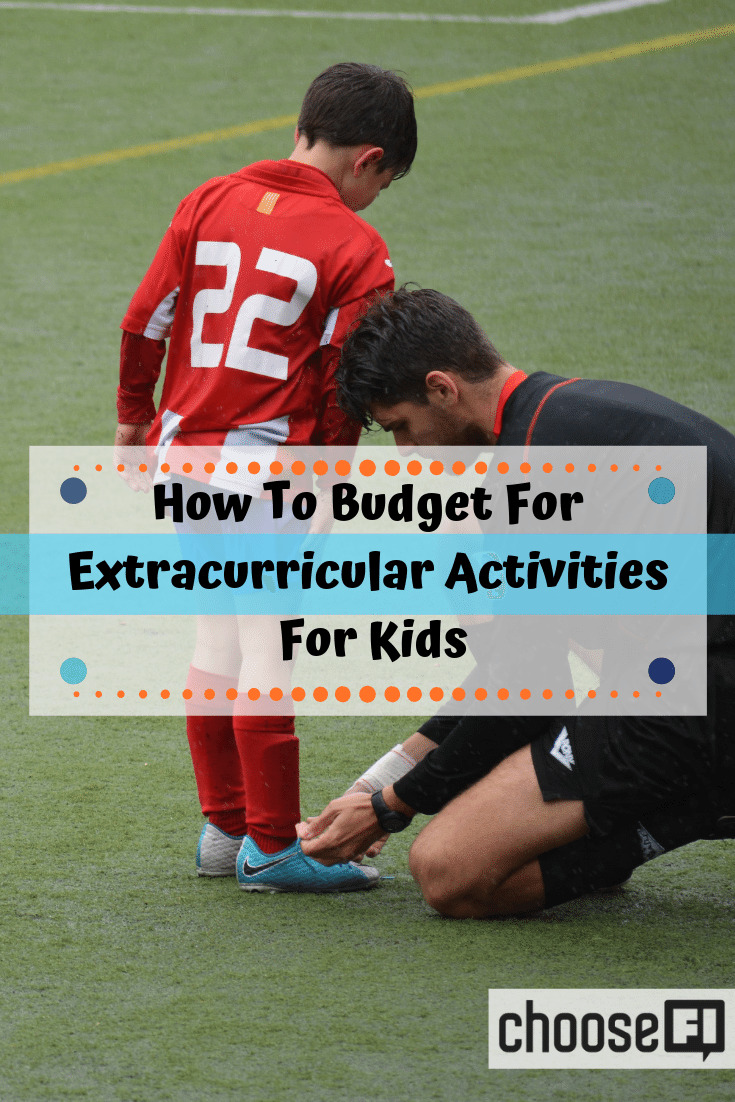Extracurricular activities have become the norm. We want our kids to be learning, occupied, and becoming well-rounded people. But some of these activities can break the bank without a bit of planning and budgeting. (And it applies to us, as adults, as well. I still love playing sports.)
Extracurricular Activities
Different types of extracurricular activities come with different price tags. And they can vary wildly, depending upon what the activity is and the area of the country you live in.
Some common sports extracurricular activities are basketball, baseball, cheerleading, dance, gymnastics, hockey, martial arts, soccer, softball, swimming, tennis, track/running, and volleyball.
Other types of extracurricular activities include acting/drama, art which could include painting, drawing, and sculpting, even gaming. Yes, video games can be an extracurricular activity. And other groups such as scouts, school clubs, church groups, and volunteering offer experiences that are great.
Even though some of these activities can be 100% free, there are certainly others that can get fairly expensive. Therefore, if you are engaging your children in multiple different activities, diversifying the costs will help your overall budget also.
Average Costs And Budget
When it comes to figuring out which activities you want to engage your kids in, one of the first things to consider is the cost. While this is not necessarily the most important factor, it is necessary to look at the activity from all angles to see how it will affect you financially.
Another factor to consider is how much time will it take out of the family lifestyle and can it be effectively managed. Be sure to include the time cost as well. Travel time, prep time, practice time, and performance time. Some tournaments for sports can be an all-day event or even more.
When considering cost and budget, all of the aforementioned activities will fall into three different categories, which should help to make a decision easier.
| Lower Cost | Mid Cost | High Costs | |
|---|---|---|---|
| Hiking | Gaming | Club Sports: Soccer, Volleyball, Gymnastics | |
| Drawing | Painting | Football | |
| Running | Camping | Hockey | |
| Swimming | Some Team/School Sports: Badminton, Swimming, Track & Field, | Competitive Dance/Drill/Cheer | |
| Tennis | School Orchestra or Band | Performing Musicians due to travel, costume, and instrument upgrades | |
| Chess | Martial Arts | Anything that goes to the "Next Level" of competition or performance. |
The first category is fairly low cost to engage in. Each person will find what they need just by getting started, as the skills and talents develop the budget might increase, or not.
A sub-set of this category is something that has an initial cost or membership but then can be enjoyed for a period of time without additional cost. For example, an annual membership at the zoo, or purchasing a drum set and teaching yourself by lessons on YouTube. Or paying whatever the school requires to participate in a school club, such as chess club or animal husbandry.
- Aquariums and Zoos
- Museums
- Music Lessons
- School Clubs
The next group of extracurricular activities falls into the middle of the road category. This is due to the fact that once you purchase the necessities you are good to go. These will usually run $200 or more to get started.
The most expensive extracurricular activities are going to be the ones that fall into the organized sports or arts category. These will usually cost you at least $1000 or more annually. You will want to budget for club fees, and equipment. Even travel can come out of your pocket.
Budgeting
Budgeting for the higher cost extracurricular activities is the hardest part. But there are some great ways to stretch your budget further in this category or increase your budget.
One of the best tricks I have used to budget for my kid’s activities was mentioned by Allison Blackford in the ChooseFI Facebook group. She says “…my in-laws give money for swimming lessons for our kids’ birthdays (at our request), and we have applied other gifted money toward activities.” Click here to read the whole Facebook thread of ideas.
This is one of the only ways I could afford to let my kids engage in extracurricular activities when I was on an extremely tight budget. So instead of asking for more toys, that they don’t need, ask for money from friends and family to put towards fun experiences for the kids just seems to make more sense.
Another great way to budget is to barter. Jenni Sisson from the ChooseFI Facebook group gives some great advice about this. She says “Barter for lessons or tutoring or childcare or some other service.” This is a great way to get some of your children’s extracurricular activities for free, especially if you have your own skills to barter with. So get creative!
One more fantastic tip about stretching your budget is to become an apprentice. Cathleen Hutch from the ChooseFI Facebook groups says “Husband once wanted to learn how to surf but couldn’t afford the board and his parents wouldn’t buy one. He found a board shaper…and convinced him to let him apprentice with him for the summer in exchange for the material and space to make his own board.”
This is a fantastic tip and one I plan to have my son work on since he wants to learn video game coding. This teaches kids the value of hard work, for no pay, but they can create their own product instead with an expert. I love this idea!
Related: Frugal Parenting: Keeping Costs Down When You Have Kids
Cheaper Equipment
And if none of those tips will work for your kid’s specific activity, there are always places to find cheaper equipment. Jackie Kaufenburg, from the ChooseFI Facebook group, says “I have been able to get a lot of sports cleats used. Kids feet grow so fast that often they are just used one year for one season. Usually, Facebook Marketplace serves me well.”
I agree with her about Facebook Marketplace, as there are a ton of groups locally just for parents buying and selling stuff. I have gotten some great deals here!
Another great place to try is Play it Again Sports if you have one locally. They buy and sell used sports equipment and will normally let you try it out before you buy.
One of my son’s favorite places to buy and sell new and used sports equipment (along with a plethora of other items) is the LetGo app. This one is geared towards your local area also and has been gaining a lot of traction lately.
City Services
When I was a very broke single mother of two, I learned to get extremely creative with my budget. Taking advantage of services offered through the city, or the Parks and Rec program, were things I regularly took advantage of.
Usually, the city or Parks and Rec department will offer a ton of classes, events, and camps throughout the year at a highly reduced cost. Ours sends out a list of all the extracurricular offerings three times a year. One for spring, one for summer, and a special one for the summer camps.
Most of the classes and activities start as low as $5. But the kid’s camps can be closer to $200 for the week. They have all of the activities previously listed, plus a lot of other things you may not even think of. Sometimes the activities listed are actually free, which is even better!
So if your kids are interested in participating in more extracurricular activities, don’t discount looking to your city or local Parks and Rec department to see what they have to offer first. This is one tip that can really help stretch your budget further while trying out a whole lot of new things.
Related: How To Find Free Things To Do In Your City
Volunteer
Volunteering is one of the best, and cheapest, ways to try new things. Most institutions are looking for volunteers on a regular basis, so it never hurts to ask.
In fact, sometimes choosing to volunteer in an area that you are interested in can actually lead to inadvertent side hustle for your teenager.
Related: Finding Your Side Hustle Idea
A lot of schools now require a certain number of volunteer hours as it is, so your child might as well volunteer with an organization they enjoy. I know the museums and zoos need a large number of volunteers on a regular basis to keep things running smoothly, so these are great places to start if you have an institution near you.
Other great places to check into volunteer opportunities are:
- Animal Shelters
- Arboretums
- Childcare Centers
- Churches
- Clothing/Food Drives
- Rescue Missions
- Soup Kitchens
If your child has been volunteering at an institution for a while, they may even be offered a paid position at some point. Albeit, these are usually minimum wage entry-level positions that are part-time, but everybody has to start somewhere. And if your child can start to get paid for something they already like doing, then what’s not to love?
In order for this to happen though, institutions look for a few things to potentially offer paid compensation. These are:
- Creativity
- Drive
- Engagement (not being on their phone the whole time!)
- Interest in the subject matter
- Listening Skills
- Punctuality
- Reliability
- Responsiveness
Don’t discount volunteering as it can open doors to future opportunities. Your child may not even be looking for a side hustle, but you just never know what can come from volunteering simply because they are interested in trying something new. Plus it puts some money in their pocket that you don’t have to pay them!
Extracurricular Activities For The Win!
Overall, there are so many extracurricular activities that our children can engage in that it’s really difficult to choose. But if your child is interested in trying new things, without breaking your budget, there are always ways to do it.
The best tips to stretch your child’s extracurricular activities budget the furthest are:
- Talk to your child. Have realistic goals. Is the goal to get to the Olympics or to learn sportsmanship, have friendships, and new skills?
- Ask for extracurricular activity money for children’s birthday’s instead of gifts
- Barter
- Apprentice
- Buy used equipment
- Enroll them in city services or Parks and Rec classes at reduced costs
- Volunteer
No matter which way you choose to go, hopefully, you will learn something new and have fun.
What are some of the best ways you have found to engage your children in, and budget for, extracurricular activities?
Related Articles
- How To Ask To Ask Your Family To Give Kids Money For Gifts
- Teach Your Kids About Money With The Goalsetter App
- 12 Cheap Summer Activities For Kids




